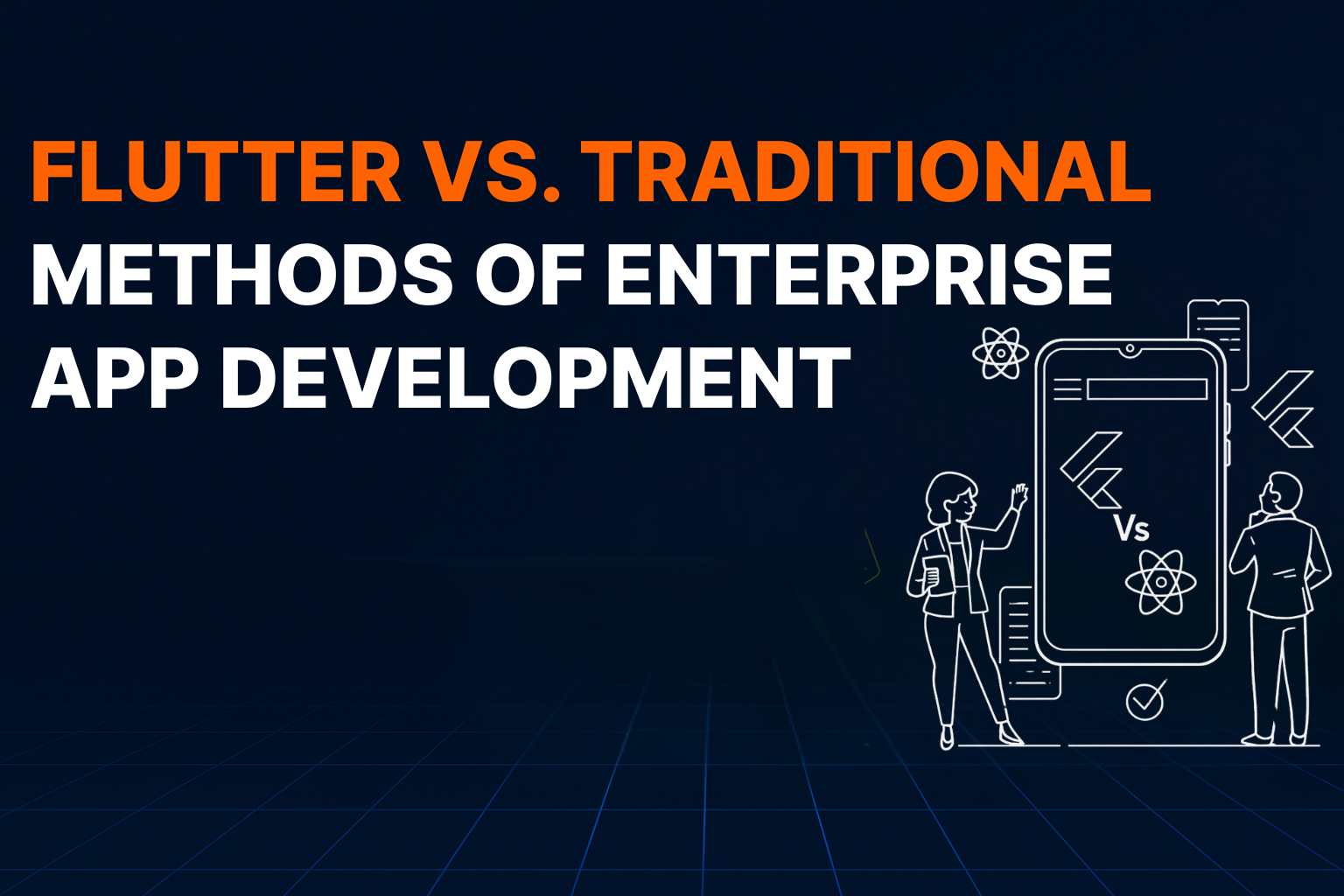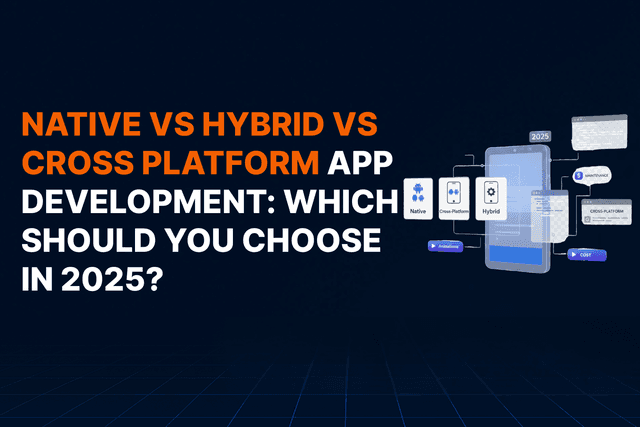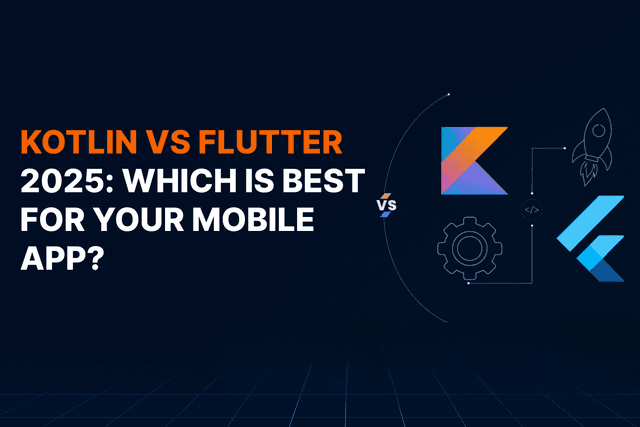Flutter vs Traditional Enterprise App Development [2025]
Flutter vs native for enterprise apps: cost, speed, performance, UI, integrations, and maintenance. A practical guide for CTOs choosing the right approach.

Flutter vs. Traditional Methods of Enterprise App Development
In the case of the development of enterprise apps, choosing the appropriate framework is essential for the success of your app. For a long time, companies have used native development methods for platforms such as iOS and Android or web-based applications for creating applications. However, the advent of cross-platform frameworks such as Flutter has altered how Enterprise Software Development Companies take on application development.
This article discusses how Flutter differs from traditional development techniques by examining its significant features, differences, and disadvantages. At the end of this blog, you'll learn why Flutter Application Development Services is becoming a cost-effective and scalable solution for companies.
What is Flutter and How Does It Work?
Flutter is an open-source UI software development toolkit developed by Google. It lets developers build natively compiled apps for mobile, web, and desktop, all from the same codebase. Flutter is powered by the Dart programming language. It is distinguished by its rapid development speed, expressive graphical user interface, and high performance.
One of Flutter's major strengths is its capacity to build cross-platform applications using one codebase. This means developers can create applications that work on iOS, Android, and the web without needing separate codebases. This drastically reduces development time and energy, an important benefit for enterprises in the market where speed-to-market is crucial.
Traditional Methods of Development
Traditional app development methods typically involve creating native apps for every platform. For instance, iOS apps are built using Swift or Objective-C, whereas Android apps are built using Java and Kotlin. HTML, CSS, and JavaScript are commonly employed for web-based applications.
Although these techniques offer deep integration with specific platforms, they have drawbacks. Native development requires teams and different skill sets specific to each operating system, which makes the process more complicated lengthy, costly, and time-consuming. On the other hand, web-based applications struggle to provide the same level of quality and experience for users as native applications, particularly in environments that require high performance and intricate functions.
Critical Differences Between Flutter and Traditional Methods
Develop Speed
Development speed is one of the most significant differences between Flutter and conventional methods. With Flutter, developers can write an identical codebase for a variety of platforms, dramatically reducing the time needed to develop. Flutter's "Hot Reload" feature allows developers to view changes in their code in real time without restarting the app, making development faster.
Contrary to this, traditional methods of development require distinct codebases specific to each device. This means that any modification in the design or functions must be implemented separately on iOS, Android, and the web, resulting in longer development cycles and higher maintenance expenses.
Cost Efficiency
Flutter can dramatically reduce the cost of creating enterprise applications. By using one codebase that is compatible with all platforms, businesses can reduce the expense of employing separate teams of developers to work on each system. Flutter offers a wide range of pre-built components, eliminating the need for custom-built development and reducing development and maintenance expenses.
On the other hand, traditional development techniques are costlier because each platform has an individual development team. This increases the costs associated with development, design tests, and subsequent updates.
Performance
Traditional native development techniques are specific to a platform; Flutter offers near-native performance. Flutter apps are built directly in native code, which ensures rapid and seamless performance across different platforms. For enterprises looking to offer an unbeatable user experience, Flutter is an excellent option for developing native apps without compromising performance.
However, some complex, performance-intensive applications may still benefit from traditional native development, where deep platform integration is essential. For the vast majority of enterprise-level applications, however, Flutter's performance is far more than sufficient.
The ability to customize and modify the UI
Flutter excels in UI customization. It has a broad selection of pre-designed widgets and the capability to design customized UI components. Developers can create attractive, user-friendly interfaces that are compatible across all platforms. Flutter also has a responsive design that ensures a seamless user experience regardless of whether the application runs on a smartphone or tablet.
Traditional methods also allow for extensive UI customization but usually require different designs for every platform. This can complicate the development process and result in inconsistent user experience across platforms.
Advantages of Using Flutter for Enterprise App Development
Cross-Platform Flexibility
Flutter's ability to create cross-platform applications using one codebase is a game changer for companies. It makes development easier, decreases time to market, and guarantees consistent performance for users on iOS, Android, and the web. This makes companies more accessible to a broader audience without the additional cost of managing multiple code bases.
Speedier time to market
In the present business climate, timing is an essential aspect. Flutter's speedy development cycles, coupled with its ability to run on multiple platforms, allow businesses to launch their applications quicker than ever. This is especially advantageous for businesses that want to get an edge in the market by being the first with innovative product features.
Cost-Effectiveness
Flutter provides substantial cost savings by reducing the requirement to have separate teams of developers to work on every platform. Enterprises can develop powerful, feature-rich apps without the expense associated with traditional development. This cost-effective approach is what makes Flutter an attractive choice for businesses looking to maximize the return on their investment.
Uniform UI
Flutter ensures that user experience (UI) is uniform for all operating systems, offering a unifying experience. This is crucial for companies that wish to maintain a consistent brand image and ensure that their users enjoy identical experiences, regardless of what device they're using.
Challenges with Flutter and Traditional Methods
Curve of Learning Curve
For those who aren't experienced in Dart, Flutter may present a learning curve. Once you've mastered it, however, the program offers many benefits in terms of speed and flexibility. Traditional methods of development are more common, and many developers are skilled with Swift, Kotlin, and Java.
Complexity of Large Projects
While Flutter is suitable for a broad range of applications, large-scale enterprise applications with extremely complicated features might still benefit from traditional development techniques, particularly when deep integration with specific platform features is needed.
Integration with Legacy Systems
Enterprises often find legacy systems that need to be integrated into their new software. Flutter allows integration with backend systems that are already in place, but traditional native development might provide more flexibility when dealing with complicated, outdated infrastructure. However, the evolution of the Flutter ecosystem is rapidly closing this gap.
Real-World Applications: Flutter vs. Traditional Methods
Numerous Enterprise Software Development Companies are moving to Flutter due to its cost efficiency and scaling capabilities. Big companies such as Google, Alibaba, and BMW have already embraced Flutter for various apps. These successes show how businesses can reap the benefits of Flutter's speedy development times, cost savings, and cross-platform capabilities.
On the other hand, traditional approaches are still in use in sectors that require deep integration between platforms or when dealing with older systems. For the majority of apps developed for enterprise, Flutter provides a compelling alternative that blends flexibility, speed, and speed.
Conclusion
Flutter offers a cutting-edge, affordable, scalable, and cost-effective solution for developing enterprise apps, providing many advantages over traditional methods. Flutter's capabilities to speed up the development process, decrease costs, and guarantee performance across all platforms, Flutter App Development Services are growing in popularity with Enterprise Software Development Companies. While traditional methods are advantageous for specific situations, the growing community and capabilities are the future of enterprise app development.
FAQs
-
What does it make Flutter superior to traditional methods of enterprise app development?
-
Flutter is a faster development tool with cost efficiency and cross-platform compatibility, making it ideal for companies.
-
Is Flutter as performant as traditional native development methods?
-
Flutter delivers near-native performance and is optimized for use in enterprise applications.
-
Can Flutter handle large-scale enterprise applications?
-
Yes, Flutter has been designed to handle the demands of scaling and handling large, complex enterprise applications that require a lot of data.
-
What are the costs and advantages of using Flutter instead of conventional methods?
-
With Flutter, businesses can manage one development team for several platforms, reducing the cost of development and maintenance.
-
What are the reasons an organization choose Flutter App Development Services?
-
Flutter Application Development Services provide speedier times to market, greater scalability, and cost savings, making them an ideal option for enterprise applications.

Gaurav Lakhani is the founder and CEO of Voxturrlabs. With a proven track record of conceptualizing and architecting 100+ user-centric and scalable solutions for startups and enterprises, he brings a deep understanding of both technical and user experience aspects. Gaurav's ability to build enterprise-grade technology solutions has garnered the trust of over 30 Fortune 500 companies, including Siemens, 3M, P&G, and Hershey's. Gaurav is an early adopter of new technology, a passionate technology enthusiast, and an investor in AI and IoT startups.

Ready for a Next-Level of Enterprise Growth?
Let's discuss your requirements
You May Also Like

App Development
Can Flutter Build Enterprise-Grade Desktop Applications? The 2025 Reality Check
An honest 2025 reality check on when Flutter desktop actually works for enterprise apps, where it struggles, and how CTOs should decide.
25 min read

Flutter Development
The Future of Apps with Flutter and LLMs: Low Code
How AI, on-device LLMs, and low-code platforms are reshaping the future of cross-platform app development.
10 min read

AI Modernization
Continuous Modernization: How Legacy Systems Are Being Refactored by AI
A deep dive into how AI-driven discovery, refactoring, testing, and governance are reshaping enterprise modernization.
7 min read

App Development
App Development Charges in 2025
Discover the real App Development Charges in 2025. Learn stage-by-stage costs, tips to save, and how VoxturrLabs helps you build smarter. Book a free consult now!
19 min read

Flutter Development
How to Read Google Sheet Data in a Flutter App
A practical guide to building dynamic, easily-updatable Flutter apps using Google Sheets as a lightweight CMS.
18 min read

MVP
MVP vs MLP: What's the Right Product Strategy for Your Startup in 2025?
How to decide whether to launch lean with an MVP or launch lovable with an MLP, with real examples, cost ranges, and a practical decision framework.
23 min read

Native vs Hybrid vs Cross Platform App Development: Which Should You Choose in 2025?
A veteran developer's honest guide to choosing between native, hybrid, and cross-platform mobile app development based on real-world constraints, not marketing hype.
24 min read

App Development
Flutter App Development Cost in 2025: Complete Breakdown
2025 guide to Flutter app development cost. See ranges from $10k to $200k+, key cost drivers, complexity tiers, region wise rates, and a simple estimate cost breakdown,
7 min read

App Development
Kotlin vs Flutter 2025: Which Is Best for Your Mobile App?
A practical comparison guide for product leaders, founders, and mobile teams choosing their cross-platform stack
16 min read
Start a conversation by filling the form
Once you let us know your requirement, our technical expert will schedule a call and discuss your idea in detail post sign of an NDA.